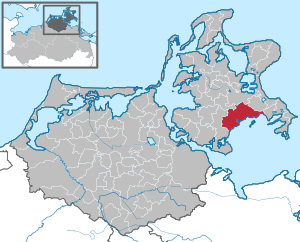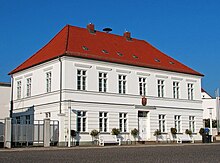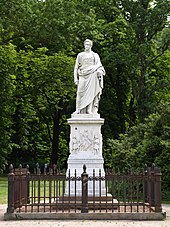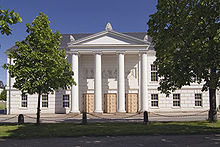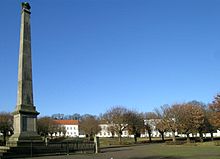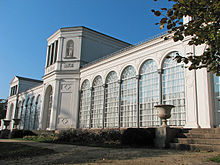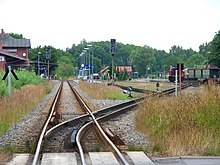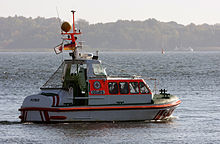Putbus
| coat of arms | Germany map | |
|---|---|---|

|
Coordinates: 54 ° 21 ' N , 13 ° 28' E |
|
| Basic data | ||
| State : | Mecklenburg-Western Pomerania | |
| County : | Western Pomerania-Ruegen | |
| Height : | 48 m above sea level NHN | |
| Area : | 66.6 km 2 | |
| Residents: | 4435 (Dec. 31, 2019) | |
| Population density : | 67 inhabitants per km 2 | |
| Postal code : | 18581 | |
| Area code : | 038301 | |
| License plate : | VR, GMN, NVP, RDG, RÜG | |
| Community key : | 13 0 73 070 | |
| LOCODE : | DE PUB | |
City administration address : |
Markt 8 18581 Putbus |
|
| Website : | ||
| Mayoress : | Beatrix Wilke | |
| Location of the town of Putbus in the district of Vorpommern-Rügen | ||
Putbus is a country town in the district of Vorpommern-Rügen in Mecklenburg-Vorpommern (Germany). Putbus is the youngest town on the island of Rügen and, with the Lauterbach district, the oldest seaside resort on the island and in Pomerania . The city has been a state-approved resort since 1997 and forms a basic center for its surroundings .
The town of Putbus was founded in 1810 by Wilhelm Malte I, Prince of Putbus , who had his hometown expanded as a planned town in the classical style so that the town ensemble fit in with the palace and park. The largely preserved city complex is one of the most important representatives of this architectural epoch . With the establishment of the first Pomeranian seaside resort in 1816 near Lauterbach and the construction of the Goor bathhouse , the spa architecture found its way onto the island of Rügen.
The name White City is derived from the white-painted houses of the Rügen prince's residence . Putbus is also Rosenstadt called because Malte linked I. the acquisition of residential buildings with the obligation always to plant rose bushes in front of houses, which is accepted today. The name Putbus comes from the Slavic epod boz and means behind the elder bush .
geography
Geographical location
The city of Putbus is eight kilometers from the city of Bergen on Rügen and is located in the Southeast Rügen Biosphere Reserve . The terrain around Putbus is slightly hilly. The coastline of the Rügischer Bodden is characterized by the alternation of flat coastline and embankments. Lake Wreech forms a deep indentation in the coastline . Lauterbach , a district with around 500 inhabitants, has a fishing and sailing port . Prince Malte had the first seaside resort on the island of Rügen built near the Goor forest , the bathhouse has been preserved. Putbus also includes the island of Vilm in the Greifswalder Bodden, 2.5 kilometers from Rügen .
City structure
The districts of the city of Putbus are:
Neighboring communities
Putbus borders the municipality of Garz / Rügen in the west, the municipality Sehlen and the city of Bergen auf Rügen in the north and the municipalities Zirkow and Lancken-Granitz in the east .
history

Putbus
The Putbus area was part of the Principality of Rügen until 1325/26 . Mentioned for the first time in 1286 as Putbus , the place was the ancestral seat of a noble family of Slavic origin. The Lords of Putbus were equal to the Rügen princes in terms of property rights and were considered their sidelines, later a fiefdom developed . After the Rügen princes died out in the 14th century, Putbus came to the Duchy of Pomerania . With the Peace of Westphalia in 1648, Rügen came under Swedish rule. In 1815 the place and Neuvorpommern came to the Prussian province of Pomerania .
The headquarters of the Lords von Putbus was the stone house . It was mentioned several times in documents in 1371. In 1416 the name changed from “house” to “castle”, which was extended in the 15th century in the Gothic style and at the beginning of the 17th century it was converted into the three-winged Putbus castle.
From 1808 to 1823 Prince Malte zu Putbus built his residence and a bathing resort in Lauterbach based on the model of Bad Doberan and Heiligendamm . The first seaside resort on Rügen was opened there in 1816. In 1817/18 Malte had the Goor bathhouse built. The Residenztheater was built from 1819 to 1821 and rebuilt again in 1826. The Marstall , built between 1821 and 1824, served Malte as a horse stable. From 1824 to 1853 he finally had the orangery built.
From 1827 to 1832 the castle was rebuilt in the classical style. The Putbus Castle Church was built between 1844 and 1846 (initially as a Kurhaus). The redesign of the palace park began in 1804, the monkey house was completed in 1830 and the pheasant house five years later.
The first bourgeois house was built in 1810 as a small brewery. The houses on the "Circus" were built between 1815 and 1860. In 1836 the former royal pedagogy was opened as an educational institution.
In 1889 Putbus received a rail connection from Bergen , and in 1895 the first section of the narrow- gauge Rasender Roland train to Binz was built .
In 1823, Prince Putbus granted city justice for trade and commerce; Putbus was not granted full city rights until July 2, 1960.

In 1962 the Putbus Castle was blown up and razed to the ground by 1964, so that only the outline of the building in the green area and the lake terrace of the castle can be seen. Putbus had a theater, an English-style park, a fairground enclosure and an orangery. From 1991 onwards, the historic city center with the circus, the market square with the town hall, the orangery and the stables as a theater were fundamentally refurbished as part of the urban development subsidy and the urban monument protection program . The white facades have also been retained or refreshed, they offer a closed city center in white.
Putbus has been a state-approved health resort since 1997.
In the 2010s, the IT college Putbus was located in what was then the first bourgeois residential building.
From 1818 to 1947 Putbus was part of the Rügen district in the Prussian province of Pomerania , then until 1952 in the state of Mecklenburg . From 1952 to 1955 the city was the administrative seat of the Putbus district in the newly established GDR district of Rostock . The Kreis Bergen was on 1 January 1956 with the county mountains to Rügen county united. From 1956 to 2011 Putbus belonged to the Rügen district in the Rostock district, from 1990 to 2011 to the Rügen district in the state of Mecklenburg-Western Pomerania . Since the district reform in 2011 , the city has been in the Vorpommern-Rügen district .
Districts (selection)
Krimvitz and the estate belonged to the von Platen family . Gottlieb von Platen was born here, known as an officer from the time of the liberation wars of 1813. He was the son of Bogislaw von Platen, Lord of Krimvitz. The estate later changed hands and came to the Putbus family until it was relocated after 1945.
Pastitz and the estate were owned by the von Putbus family until 1945, except between 1442 and 1532. The neo-baroque manor house deteriorated after 1987 and was renovated from 2004 to 2006.
Posewald and the estate were owned by the von Putbus family (until 1327, from the 15th century and after 1850 to 1945). The city of Stralsund owned the estate from the 17th century until 1687. The striking manor house dates from the 2nd half of the 19th century. After 1945 until the 1990s it was occupied by apartments. In 2001 the Förderverein Modellregion Rügen leased and renovated the house.
Population development
|
|
Status: December 31 of the respective year
In 1962 the city had 6100 inhabitants, in 1976 it was 5500.
politics
City council
The Putbusser city council consists of 15 members. Since the local elections on May 26, 2019, it has been composed as follows:
| Party / list | Share of votes in 2009 |
Share of votes in 2014 |
Seats 2014 | Share of votes in 2019 |
Seats 2019 |
||
|---|---|---|---|---|---|---|---|
| CDU | 31.1% | 35.8% | 5 | 39.8% | 6th | ||
| Our knowledge for Putbus (UwfP) | 6.1% | 8.1% | 1 | 16.7% | 3 | ||
| The left | 13.4% | 11.4% | 2 | 10.2% | 2 | ||
| Individual applicant Horst Korn | - | - | - | 9.8% | 1 | ||
| GREEN | 3.2% | 5.0% | 1 | 8.5% | 1 | ||
| SPD | 11.0% | 14.3% | 2 | 7.6% | 1 | ||
| FDP | 11.8% | 4.4% | 1 | 4.2% | 1 | ||
| Future for Putbus | 7.5% | 7.6% | 1 | - | - | ||
| Alliance for Rügen (BfR) | 6.3% | 5.7% | 1 | - | - |
mayor
- 2001–2015: Harald Burwitz (FDP)
- since 2015: Beatrix Wilke (independent)
Wilke was elected in the mayoral election on September 27, 2015 with 50.7% of the valid votes for a term of seven years.
coat of arms
The coat of arms of Putbus was approved by the chief president in Stettin on December 9, 1938 and registered under the coat of arms roll no. 195 of Mecklenburg-Western Pomerania .
The coat of arms has the following blazon : “Divided; at the top in red, between twelve-pointed deer antlers with scab, a silver shield inside a gold-armored red griffin head; below box of black and gold. "
flag
The flag of the city of Putbus is evenly striped lengthways in black and gold (yellow). In the middle of the flag is the city coat of arms, two-thirds of the height of the black and gold (yellow) stripes. The length of the flag is related to the height as 5: 3.
Town twinning
Putbus maintains city partnerships with the cities of Eutin and Rewal in Poland . The partnership with Eutin has existed since October 3, 1990. The partnership with Rewal / Poland was concluded on May 23, 2002.
Sights and culture
Putbus
- Castle Park
The palace park was laid out in 1804 by Wilhelm Malte I in the style of a French park. Later it was continued in the style of an English landscape park . It offers numerous beautiful views of the lagoon landscape. The orangery from 1824, the royal stables from 1821 to 1824, the mausoleum from 1867, the castle church from 1844 to 1846, the parish church and the monkey and bird house from 1830/35 are also preserved. The Castle Putbus , once surrounded by a park, was demolished in the 1960s. The park also offers other dendrological features such as giant and primeval sequoia trees , cedars , yellow-flowering horse chestnuts and tulip trees . Attached to the park is a game reserve where red and fallow deer live.
- Orangery
The Orangery Putbus is a classical building from 1853 and is used as an exhibition and event building.
- Stables
The royal stables were used to house horses, harnesses and carriages for the royal family and their guests, as well as to accommodate the horse grooming staff. The surroundings of the Marstall in the Putbusser Schlosspark also included the riding school and the old forge . In 1817 the first performance of plays for guests took place in a coach house in the old riding stable. After the demolition, the new construction of the Marstall began around 1821–1824 in the classicism style with 16 arched windows and three arched portals, presumably based on plans by the Berlin architect Johann Gottfried Steinmeyer . A tondo with a horse relief decorates the eastern gable of the building .
- Castle Church
The Christ Church is a three-aisled church from the 19th century. It is located in the castle park and was originally the resort's health resort.
- mausoleum
The church of St. Maria Magdalena in Vilmnitz originally served as the family grave of the von Putbus family. It was not until 1867 that the neo-Gothic style mausoleum, which is still preserved today, was built on the grounds of the castle park . Wanda von Putbus, the wife of Prince Wilhelm Malte II zu Putbus (1833–1907) , was buried there in 1868 as the first member of the family .
- Former Putbus Castle
The Castle Putbus in Castle Park was the former stately headquarters of the Prince of Putbus. The building was blown up in 1962 and demolished by 1964. The original location of the castle is now marked with the help of metal posts, which illustrate the outline of the building in today's green space. Only the lake terrace of the castle is preserved.
- Residenztheater
The Putbus Theater is an important historical theater and is used today as a venue for the Vorpommern Theater .
- Circus

Classicist buildings line this circular square where all the streets come together. A strictly structured park fills the inner ring of the square, the center of which is marked by a towering obelisk . The Circus Putbus is the last uniformly designed roundabout in Germany, which Prince Wilhelm Malte I created in connection with the establishment of the educational center based on the model of the "Circus" in the English seaside resort of Bath and French facilities from 1828 and essentially until 1845 with classical ones Had houses rebuilt. All the buildings that were built at the time of Prince Malte I are still there today, only the buildings were given different tasks. The Putbus Royal Education Center housed the Putbus IT College until 2014. The next alumnate of the Royal Pedagogy, which was built by Schiffer Wilcken around 1835, is now the seat of the IT Science Center.
- Former Putbus pedagogy
The largest house on the circus is the former Putbus pedagogy , which was built between 1833 and 1836 according to plans by Johann Gottfried Steinmeyer. From 2002 to 2014 Pädagogium IT College Putbus was staying, a private training institution for computer science professionals . The building was auctioned to an unknown telephone bidder on December 6, 2015.
It was Prince Malte zu Putbus who wanted to give his princely seat a higher education institution with the aim of promoting the education and upbringing of his country's children. So he had the house at Circus 16 built in 1833. The Princely Pedagogy at Putbus was built with a boarding school, cafeteria and gym. In 1836 he handed it over to the Prussian state as the Pädagogium Regium (Royal Pedagogy). Until the Second World War, after the University of Greifswald, education was the most important educational institution in Western Pomerania. From 1941 to 1945 the Rügen National Political Education Institute was housed in the building. After the Second World War, teachers were trained from 1946 to 1975. At times there were 200 students in training. From 1975 to 1994 hard of hearing children were educated in the buildings. In 1994, the “Foundation Association for Multiple Disabled Deaf, Hard of Hearing and Deaf-Blind People eV” took over the facility. From 2000 to 2002 the historic building was partially empty and was left to decay because the “Special Education Center for the Hearing Impaired with Multiple Disabilities” moved into a new building complex in Putbus.
To the west of the city is the so-called Primanerloch , which goes back to a custom at the pedagogy.
- August-Bebel-Strasse
In August-Bebel-Straße there are still numerous single-storey craftsmen's houses from the time the city was founded.

- Museums
The Putbuss clock museum shows over 1000 clock exhibits from the 15th to 19th centuries. There is also a doll and toy museum in town.
Districts
- Church in Kasnevitz
The St. Jacobi Church from the 2nd half of the 14th century is located in Kasnevitz .
- Bathhouse and forest area Goor in Lauterbach
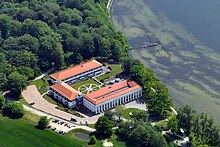
The Goor bathhouse was built between 1817 and 1818 in the classicism style. Its name is derived from the protected forest area near Lauterbach (Rügen) .
- Memorial stone in Lauterbach on the grounds of the bathhouse
The memorial stone for the victims of fascism, inaugurated in 1978, commemorates the forced evacuation of the Stutthof concentration camp in April 1945. The memorial stone was created by the sculptor Werner Stötzer with an inscription by the Czech writer Julius Fučík : People I loved you. After the ash urn was destroyed and stolen in 1990, the facility was re-inaugurated in 1995.
- House-head-over near Lauterbach
In 2010, private individuals built a completely upside-down wooden house on the road to Lauterbach as a visitor attraction.
- Great stone graves near Lonvitz
Between Lonvitz and Lauterbach, on the Rasender Roland railway line, there are large stone graves near Lonvitz ( ) from the Neolithic period .
![]()
- Pastitz manor house
The neo-baroque manor house deteriorated after 1987 and has been renovated since 2004.
- Posewald manor house
Two-storey, refurbished plastered building on a stone cellar from the 2nd half of the 19th century with two three-storey corner towers.
- Church in Vilmnitz
The church of St. Maria Magdalena zu Vilmnitz is a late Romanesque / Gothic brick church .
Technical equipment
- Narrow gauge railway
Putbus is the starting point for the Rasender Roland narrow-gauge railway (gauge 750 millimeters) from the Lauterbach district via Binz to Göhren . This daily running railway was built between 1895 and 1899 and has mainly served tourism since the end of the 20th century. Class 99.48 (built in 1938) and 99.78 (built in 1953) steam locomotives are used. It was not until 1999 that the line was extended to Lauterbach (Mole). For this purpose, the standard-gauge railway line Bergen – Lauterbach (Mole) in the section between Putbus and Lauterbach was extended by another rail to form a three-rail track system.
In 1999, according to plans by Stralsund architect Niclas Dünnebacke, a modern gas station building was built, which is combined with the small train station.
On July 4, 1896, the 35.5 km stretch from Altefähr to Putbus was opened. Due to insufficient utilization, traffic on this route was stopped in December 1967. Today the route can be used as a cycling and hiking trail.
- Transmitter
A transmission system for medium wave was located near Putbus . During the GDR times, this system was used to distribute the program for Radio GDR Ferienwelle. The Deutschlandradio Kultur program was broadcast from there in DRM mode until 2009 . The antenna for the one-kilowatt transmitter was a 51-meter-high, guyed steel truss mast , which was built in 1960 and insulated from the ground, with a cross-shaped roof capacity on top.
The medium wave transmitter Putbus on 729 kHz was the last of its kind in Mecklenburg-Western Pomerania. In order to save it from dismantling after the fall of the Wall, the media authority put out a tender in mid-2010 to find private operators. In addition to Western Pomerania, the station would also reach Rügen and Usedom as well as parts of southern Sweden and Schleswig-Holstein. However, there was no interested party and the transmitter mast was dismantled in mid-2012.
It is worth mentioning a weather radar system with a special radome , the data of which is incorporated into the German Weather Service .
Regular events
From the Putbuss event calendar, the following regular events with great regional or national awareness are worth mentioning:
- May: Putbus Festival - music concerts at various locations in Putbus
- June: Rügener Holzmesse - Exhibition in Lauterbach about the natural raw material wood (since 1997)
- July: Sailing and harbor festival in the Lauterbach district of Putbuss
- August: Vilmschwimmen - traditional swimming competition on the route between the island of Vilm and the port of Lauterbach
- September: Cabaret Regatta Rügen - The elite and talented youngsters of German cabaret have been performing in the Residenztheater Putbus since 1997.
Economy and Infrastructure
traffic
- Road traffic
The state road 29 runs through Putbus between Stralsund and Sassnitz , which belongs to section 1 of the Deutsche Alleenstraße . Putbus is also connected to the city of Bergen on Rügen via state road 301.
- Rail transport
Putbus station is on the Bergen auf Rügen – Lauterbach Mole railway and on the steam-powered narrow-gauge railway “ Rasender Roland ” from Lauterbach (Mole) via Putbus, Binz , Sellin and Baabe to Göhren . The common section of both railway lines from Putbus to Lauterbach Mole was equipped with a special three-rail system for 750 mm and 1435 mm gauge. This means that trains from both track systems (narrow-gauge and regular-gauge operation) can run alternately on the section. The next long-distance train station with IC connection is in Bergen on Rügen, nine kilometers away.
- Bus transport
In local public transport , the municipality is connected by the Vorpommern-Rügen transport company with line 30 ( Bergen - Putbus - Garz - Stralsund ). Other buses run to the remote villages.
- Shipping
The former fishing village Lauterbach, located on the Rügischer Bodden , is now part of the town of Putbus. Various excursions are offered from the port of Lauterbach during the summer season, including trips around the island of Vilm in the Southeast Rügen Biosphere Reserve as well as Bodden cruises through the Rügen Bodden.
On June 7, 1993 was Lifeboat of the German Society for Sea Rescue in the name Putbus baptized and is now stationed in the port of Lauterbach. The DGzRS internally designated ship SRB 37 was built in 1993 by the Fassmer shipyard in Berne under construction no. Built in 1261 and has the callsign DH 3.
media
The Ostsee-Zeitung with its local section Rügen is available to Putbussers as a regional daily newspaper .
The Putbusser Druckerei Rügenruck am Circus has been producing the tourist information magazine Rügen aktuell for the island of Rügen and the Hanseatic city of Stralsund since 1992 ; the editorial department has also been here in the publishing department since 1997. The magazine appears monthly or bi-monthly in double editions during the off-season.
Personalities
sons and daughters of the town
- Gottlieb von Platen (1765–1819), Prussian major general, born in Krimvitz
- Wilhelm Malte I , Prince of Putbus (1783–1854), city founder
- Berthold Delbrück (1842–1922), linguist
- Georg von Rechenberg (1846–1920), Prussian lieutenant general
- Alfred Biese (1856–1930), literary historian
- Hermann Lietz (1868–1919), reform pedagogue, born in Dumgenevitz
- Hermann Schoemann (1881–1915), naval officer
Personalities associated with Putbus
- Moritz Ulrich I. (1699–1769), Count and Lord of Putbus
- Charlotte von Kathen (1777–1850), landlady, lived in Putbus
- Johann Gottfried Steinmeyer (around 1780–1851), architect in Putbus
- Karl von Hahn (1782–1857), landowner and theater director, initiator of Putbus's first theater ambitions
- Ferdinand Hasenbalg (1793–1852), pedagogue, director of the Putbus pedagogy
- Franz Biese (1803–1895), philologist and literary historian, senior teacher at the Putbus pedagogy
- Wilhelm Malte II (1833–1907), Prince and Lord of Putbus
- Gustav Staude (1843–1909), Lord Mayor of Halle (Saale), graduated from high school in Putbus
- Gerhart Hauptmann (1862–1946), playwright and writer, assisted as a director at the Princely Theater
- Arnold Wahnschaffe (1865–1941), head of the Reich Chancellery, attended the education department in Putbus
- Malte of Putbus (1889-1945), large landowners, heir to the former Renaissance Putbus'schen Fideikommiss
- Otto R. Gervais (1902–1952), publicist and writer, owner of the photo agency “Inseldienst Rügen”, lived and died in Putbus
- Hans Marquardt (1920–2004), publisher, lived in Putbus
- Hans Knötzsch (1923–1996), actor and director at the Putbus Theater
- Heinz Kahlow (1924–2015), writer, directed the Studio 48 theater group in Putbus
- Jürgen Frohriep (1928–1993), actor, member of the Studio 48 theater group in Putbus
- Egon Krenz (* 1937), politician (SED), studied at the Putbus Institute for Teacher Training
- Dirk von Bodisco (1940–2008), stage and costume designer, lived in Putbus
literature
- BIG-Städtebau (publisher): Putbus - 10 years of urban development funding . Stralsund 2001
- Andre Farin: Wilhelm Malte zu Putbus and his royal residence on the island of Rügen. A biography about a north German founder personality of the 19th century . 5th, extended edition, Putbus 2012, ISBN 3-00-008844-X .
- Peter Feist: Putbus. City of classicism . Kai Homilius Verlag , Berlin 1995, ISBN 3-931121-06-2 , ( reading sample ).
- Otto R. Gervais: Inselstadt tax office. Novel of an evasion , FA Herbig Verlagbuchhandlung, Berlin 1948.
- Gerhart Hauptmann : In the vortex of calling! S. Fischer Verlag, Berlin 1936
- Andreas Vogel: Johann Gottfried Steinmeyer and Putbus . Thomas Helms Verlag , Schwerin 2003, ISBN 3-931185-82-6 .
- Johannes Friedrich Weise: Between beach life and agriculture. Putbus reign in the 19th century . Koch Verlag, Rostock 2003, ISBN 3-935319-93-2 .
Web links
Individual evidence
- ↑ Statistisches Amt MV - population status of the districts, offices and municipalities 2019 (XLS file) (official population figures in the update of the 2011 census) ( help ).
- ↑ Regional Spatial Development Program Vorpommern (RREP) 2010 ( Memento of the original from September 24, 2015 in the Internet Archive ) Info: The archive link was inserted automatically and has not yet been checked. Please check the original and archive link according to the instructions and then remove this notice. - Central local structure with regional, medium and basic centers, accessed on July 12, 2015
- ↑ a b c main statute of the city of Putbus, § 1
- ↑ a b Meyer's New Lexicon in eight volumes. VEB Bibliographisches Institut Leipzig, 1964/65, Volume 6, p. 756, p. 62.
- ↑ a b Facts and figures about Putbus at www.putbus.de; accessed on November 5, 2019.
- ^ Hubertus Neuschäffer: Western Pomerania's castles and mansions. Husum Druck- und Verlagsgesellschaft 1993, p. 104, ISBN 3-88042-636-8 .
- ↑ Population development of the districts and municipalities in Mecklenburg-Western Pomerania (Statistical Report AI of the Statistical Office Mecklenburg-Western Pomerania)
- ^ Lehmann / Meyer: Rügen AZ , Wähmann-Verlag, Schwerin, 1976.
- ^ Result of the local election on May 26, 2019
- ↑ New mayor appointed on Rügen. In: Ostsee-Zeitung . November 26, 2015, accessed July 21, 2020 .
- ↑ Main statute of the city of Putbus, § 8
- ^ Result of the mayoral election on September 27, 2015
- ↑ Sister cities. Retrieved December 20, 2017 .
- ↑ Putbus - A place to stay ( page no longer available , search in web archives ) Info: The link was automatically marked as defective. Please check the link according to the instructions and then remove this notice. (PDF; 742 kB), accessed on July 22, 2010
- ↑ IT-College Putbus website ( Memento of the original from June 6, 2013 in the Internet Archive ) Info: The archive link was inserted automatically and has not yet been checked. Please check the original and archive link according to the instructions and then remove this notice.
- ↑ History of the transmitter ( Memento from May 14, 2009 in the Internet Archive ), accessed on July 22, 2010.
- ↑ radioeins.de: MW antenna dismantled in Putbus ( Memento from February 11, 2013 in the web archive archive.today )
- ↑ Putbus weather radar ( Memento of the original from September 28, 2010 in the Internet Archive ) Info: The archive link was inserted automatically and has not yet been checked. Please check the original and archive link according to the instructions and then remove this notice. , accessed September 30, 2010
- ↑ Grete Grewolls: Who was was in Mecklenburg-Vormpmmern. The dictionary of persons. Hinstorff-Verlag, Rostock 2011.

